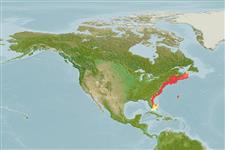Issue
This species is placed in the genus Paralichthys Girard, 1858 in Eschmeyer (CofF ver. May 2011: Ref. 86870) following various check-lists and faunas. We follow T. Munroe (pers. comm., June 2011) keeping it in Hippoglossina.
Environment: milieu / climate zone / distribuzione batimetrica / distribution range
Ecologia
marino demersale; distribuzione batimetrica ? - 311 m (Ref. 5951). Temperate; 48°N - 23°N, 83°W - 57°W
Western Atlantic: Canada (Ref. 5951) and Georges Bank to southern Florida, USA.
Size / Peso / Age
Maturità: Lm ? range ? - ? cm
Max length : 49.0 cm TL maschio/sesso non determinato; (Ref. 49746)
Occurs in bays and sounds in the north range; in progressively deeper water to 275 m or more off Florida, USA.
Distinct pairing (Ref. 205).
Robins, C.R. and G.C. Ray, 1986. A field guide to Atlantic coast fishes of North America. Houghton Mifflin Company, Boston, U.S.A. 354 p. (Ref. 7251)
IUCN Red List Status (Ref. 130435: Version 2025-1)
Threat to humans
Harmless
Human uses
Pesca: commerciale
Strumenti
Special reports
Download XML
Fonti Internet
Estimates based on models
Preferred temperature (Fonte Biblio.
123201): 4.6 - 23.6, mean 7.9 °C (based on 76 cells).
Phylogenetic diversity index (Fonte Biblio.
82804): PD
50 = 0.5078 [Uniqueness, from 0.5 = low to 2.0 = high].
Bayesian length-weight: a=0.00501 (0.00421 - 0.00596), b=3.12 (3.07 - 3.17), in cm total length, based on LWR estimates for this species (Ref.
93245).
Trophic level (Fonte Biblio.
69278): 4.3 ±0.1 se; based on diet studies.
Resilienza (Fonte Biblio.
120179): Medio, tempo minimo di raddoppiamento della popolazione 1.4 - 4.4 anni (Preliminary K or Fecundity.).
Fishing Vulnerability (Ref.
59153): Moderate vulnerability (39 of 100).
🛈
Nutrients (Ref.
124155): Calcium = 43.1 [17.9, 75.5] mg/100g; Iron = 0.333 [0.152, 0.621] mg/100g; Protein = 17.3 [15.1, 19.3] %; Omega3 = 0.425 [0.220, 0.842] g/100g; Selenium = 16.6 [8.0, 37.5] μg/100g; VitaminA = 8.97 [1.99, 42.86] μg/100g; Zinc = 0.365 [0.243, 0.558] mg/100g (wet weight);
